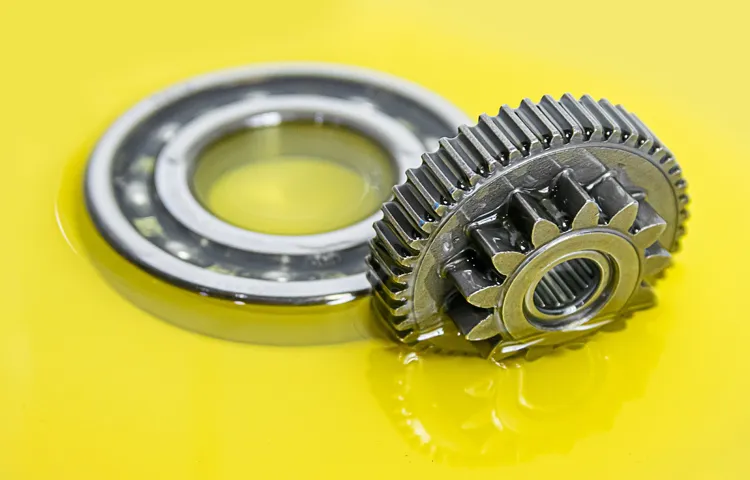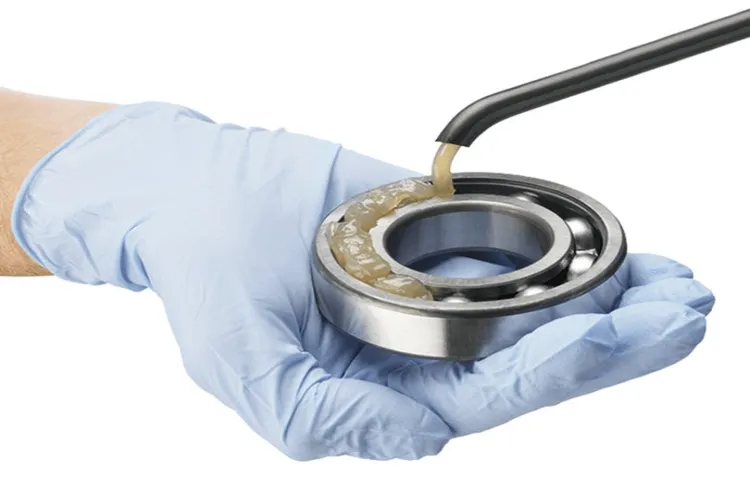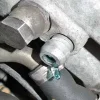Have you ever wondered how much grease your bearings need? Understanding the correct amount of grease for your bearings is vital in ensuring their longevity and performance. Too little grease could result in premature wear and tear, while too much grease could lead to overheating and decreased efficiency. Finding the right balance is key.
Think of a bearing like a wheel on a bike. Just like how too much air or too little air in the tire can cause issues, having the correct amount of grease is crucial for a smooth ride. Grease acts as a lubricant to reduce friction and wear between the moving parts of the bearing.
So, how much grease does a bearing need? The answer depends on various factors, such as the size and type of bearing, the operating conditions, and the application. Over-greasing a bearing can lead to high temperatures, which can cause the grease to break down and lose its lubricating properties. Under-greasing a bearing can also lead to metal-to-metal contact and premature failure.
To avoid these issues, it’s important to consult the manufacturer’s recommendations and follow proper maintenance procedures. Regularly lubricating bearings can also help prevent issues and increase their lifespan. Remember, finding the right balance is key to keeping your bearings rolling smoothly.
Table of Contents
Understanding the Importance of Greasing Bearings
Knowing how much grease a bearing needs is essential in ensuring its proper functioning and longevity. A bearing that is not greased enough can overheat, causing damage to the bearings and other crucial components of the machinery. On the other hand, over-greasing can result in wastage of grease, increased friction, and resistance that can eventually lead to early wear and tear of the bearing.
So, it is crucial to determine the amount of lubricant required for each bearing to function correctly. However, there is no set amount of grease that applies to all bearings, as it largely depends on the size and type of bearing, operating conditions, and type of application. Therefore, it is crucial to refer to the manufacturer’s recommendation for the amount and interval of lubrication required for each bearing.
In summary, understanding how much grease a bearing needs is essential in preventing bearing failure, improving performance, and reducing downtime and maintenance costs.
Explanation of the Purpose of Greasing Bearings
Greasing bearings is a crucial step in ensuring the smooth operation of rotating machinery. The primary purpose of greasing bearings is to reduce friction between the moving parts, which can cause damage and wear over time. When bearings fail due to lack of lubrication, they become noisy and may even break, resulting in costly repairs or replacements.
Regular greasing of bearings also helps to prevent corrosion, contamination, and overheating. Choosing the right type and amount of grease is important, as it can affect the performance and lifespan of the bearings. In short, greasing bearings ensures that the equipment runs smoothly, extends its service life, and saves money on maintenance costs.
So, always remember to grease your bearings regularly to keep your machinery in optimal condition.

Consequences of Neglecting to Grease Bearings
As a machine owner or operator, it’s essential to understand the impact of neglecting to grease bearings. Bearings are the critical components that enable the smooth movement of rotating parts, and without regular maintenance, their durability and efficiency gradually decline. Failing to lubricate bearings results in increased friction, leading to wear and tear, emissions of heat, and overall machine malfunction.
It’s much like running a car engine without oil, which can cause overheating and unbearable grinding noise. The consequences of neglecting to grease bearings can be disastrous, leading to costly repairs or even a complete machine breakdown. Therefore, inspecting, cleaning, and lubricating bearings regularly should be an integral part of any machine maintenance routine.
By taking care of your bearings, you will extend their lifespan and ensure the smooth operation of your machine.
Determining the Amount of Grease Required for Your Bearings
If you’re wondering how much grease your bearings need, the answer largely depends on the bearing size and type, as well as the environment in which it operates. In general, the amount of grease needed for a bearing is determined by the bearing’s internal space or cavity. You can calculate this volume using the bearing’s dimensions and subtracting the space taken up by the rolling elements and cage.
Once you have the cavity volume, you can determine the amount of grease required based on the desired fill level or the percentage of the available cavity space that should be filled with grease. It’s important to note that over-packing with grease can lead to overheating and premature bearing failure, while under-packing can lead to insufficient lubrication. Additionally, the operating speed and load of the bearing can also impact the amount of grease required, so it’s always best to consult with the bearing manufacturer’s recommendations.
Ultimately, ensuring your bearings are properly lubricated can help extend their service life and prevent costly downtime.
Factors Affecting the Grease Requirements for Bearings
One critical aspect of bearing maintenance is ensuring that you use the right amount of grease. Over-lubrication or under-lubrication can both lead to bearing failure and expensive repairs. To determine the amount of grease required for your bearings, you need to consider factors such as bearing type, speed, load, and operating temperature.
For instance, higher speeds and loads require more lubrication, while high temperatures can cause the grease to break down quickly. It’s also important to know the manufacturer’s recommendations for the type and amount of grease to use. A good rule of thumb is to fill the bearing housing cavity about 1/3 to 1/2 full with grease, but be sure to check the manufacturer’s specifications for the proper amount.
By taking these factors into account, you can keep your bearings running smoothly and avoid premature failure.
Methods for Calculating the Required Amount of Grease for Bearings
Determining the Amount of Grease Required for Your Bearings can be done through various methods. One popular method is by using the bearing’s housing volume to calculate the necessary amount of grease. Another method is by calculating the bearing’s dynamic equivalent load and selecting a grease that can handle the load, then applying a specific amount based on the manufacturer’s recommendations.
It’s important to consider the bearing’s operating conditions, such as temperature and speed, as they can affect the grease’s performance and lifespan. Properly calculating and applying the required amount of grease can prolong the bearing’s life, prevent premature failure, and ultimately save you time and money in the long run. Don’t be afraid to consult with manufacturers or industry experts if you are unsure about the appropriate amount of grease for your bearings.
Tips for Applying Grease to Bearings
When it comes to applying grease to your bearings, determining the right amount to use is crucial. Too little grease may cause your bearings to wear out prematurely, while too much grease can cause excess heat and pressure buildup, leading to failure. The first step in determining the proper amount to use is to consult the manufacturer’s recommendations, which will typically outline the filling level or gauge range for your specific bearing type.
You can also calculate the required amount based on the bearing’s size, speed, and operating conditions. It may take a bit of trial and error, but finding the right amount of grease to keep your bearings running smoothly and efficiently is well worth the effort.
Conclusion and Final Thoughts
In conclusion, determining the exact amount of grease a bearing needs is like balancing on a tightrope – too little grease can lead to premature wear and tear, while too much can cause overheating and failure. It requires a delicate balance of understanding the bearing’s specific needs, the operating conditions, and proper lubrication techniques. So, the solution to the age-old question of “how much grease does a bearing need?” lies in finding just the right amount, not too little, not too much – just enough to keep things rolling smoothly.
“
Summary of Key Points
Determining the right amount of grease for your bearings is crucial in maintaining their longevity and ensuring smooth operation. The first step in determining the amount of grease needed is to identify the bearing’s size and type. This information can generally be found on the bearing itself or in the manufacturer’s documentation.
The next step is to calculate the bearing’s grease capacity, which is determined by its size and type. Once grease capacity is determined, the next step is to calculate the amount of grease required for the bearing’s specific application. Over-greasing can cause excess pressure on the seals and lead to premature failure, while under-greasing can result in inadequate lubrication and accelerated wear.
By calculating the appropriate amount of grease required, you can avoid these issues and keep your bearings operating at peak performance.
Need for Regular Maintanence of Bearings
When it comes to the maintenance of bearings, one of the key aspects to consider is the amount of grease required. Over-greasing or under-greasing can both lead to negative consequences, so it’s crucial to get the amount just right. The easiest way to determine the right amount is to consult the manufacturer’s guidelines.
These will typically include information on the type of grease to use, as well as the recommended amount. If this information isn’t readily available or if you need to make adjustments for your specific application, you may need to consult with a professional or conduct some tests. It may take some trial and error to find the perfect amount, but it will be well worth it in the end to ensure that your bearings are properly lubricated and working at their full potential.
Final Note on Proper Handling of Bearings
Determining the amount of grease required for your bearings is an important step in ensuring their proper functioning. Over-greasing can lead to higher temperatures, increased drag, and even early bearing failure, while under-greasing can cause excessive wear and friction. So, how do you determine the proper amount of grease for your bearings? The simple answer is to consult the manufacturer’s specifications, which will typically provide guidance on the optimum fill level.
However, it’s important to keep in mind that the fill level may vary depending on the application and operating conditions. Factors such as speed, load, and temperature should be taken into account when determining the appropriate amount of grease to use. A general rule of thumb is to fill the bearing cavity one-third to one-half full, but always refer to the manufacturer’s recommendations for best practice.
By properly greasing your bearings, you can extend their lifespan and increase their efficiency, ultimately saving you time and money down the line.
FAQs
What is the recommended amount of grease to be applied to a bearing?
The recommended amount of grease for a bearing depends on its size and application. It is best to refer to the manufacturer’s guidelines or consult with a professional for proper lubrication.
Can applying too much grease damage a bearing?
Yes, over-greasing a bearing can cause excessive heat and pressure, leading to premature failure. It can also attract contaminants, leading to further damage. It is important to apply the right amount of grease.
How often should a bearing be re-greased?
The frequency of re-greasing a bearing depends on various factors such as application, environment, and load. It is best to refer to the manufacturer’s guidelines or consult with a professional for proper maintenance.
What are the signs of over-greasing a bearing?
Signs of over-greasing a bearing can include leakage, increased operating temperatures, and strange noises. If any of these symptoms are noticed, it is important to immediately address the issue to prevent further damage.
Can different types of grease be used on the same bearing?
It is not recommended to use different types of grease on the same bearing. The mixing of incompatible greases can lead to reduced performance and premature failure. Always use the same type of grease if re-greasing a bearing.
Can insufficient grease cause bearing failure?
Yes, insufficient grease can cause bearing failure due to increased friction and heat, leading to premature wear. It can also lead to contamination and corrosion. Always ensure to apply the proper amount of grease.
Can high-temperature grease be used on a bearing?
Yes, high-temperature grease can be used on bearings that operate in extreme conditions. It is important to select the proper grease based on the application and operating temperature range. Consult with a professional if unsure.



